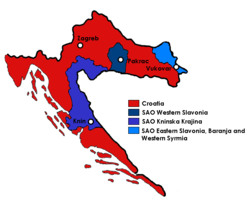SAO Krajina
| Serbian Autonomous Oblast of Krajina | ||||||||||
|
Srpska autonomna oblast Krajina Српска аутономна област Крајина |
||||||||||
| Unrecognized entity seeking unification with Serbia | ||||||||||
|
||||||||||
|
SAO Krajina (eastern purple area) within SR Croatia (red).
|
||||||||||
| Capital | Knin | |||||||||
| Government | Provisional government | |||||||||
| Historical era | Breakup of Yugoslavia | |||||||||
| • | Proclaimed autonomy from the government of Croatia | 1 August 1991 | ||||||||
| • | Declared itself the Republic of Serbian Krajina | 19 December 1991 | ||||||||
|
||||||||||
The Serbian Autonomous Oblast of Krajina (Serbo-Croatian: Srpska autonomna oblast Krajina, Српска аутономна област Крајина) or SAO Krajina (САО Крајина) was a self-proclaimed Serbian autonomous region (oblast) within modern-day Croatia (then Yugoslavia). The territory consisted of majority-Serbian municipalities of the Republic of Croatia that declared autonomy in August 1990. It was formed as the SAO Kninska Krajina, but, upon inclusion of additional Serb-populated areas, changed its name simply to SAO Krajina. In 1991 the SAO Krajina declared itself the Republic of Serbian Krajina, and subsequently included the other two Serbian SAOs in Croatia, the SAO Western Slavonia and the SAO Eastern Slavonia, Baranja and Western Syrmia.
After the Croatian multi-party elections in 1990, ethnic tensions within Croatia increased. The Croatian President Franjo Tuđman was planning Croatia secession from Yugoslavia, so, in anticipation, Serb leaders created an autonomous region around the city of Knin. Initially, this was dubbed the SAO Kninska Krajina, but, after joining with the Association of Municipalities of Northern Dalmatia and Lika, it was renamed SAO Krajina in October 1990.
...
Wikipedia


